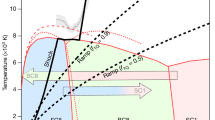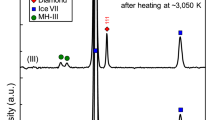Abstract
Diamond is the only known high-pressure structure of carbon. In spite of its fundamental and planetary importance, the stability domain of this strong covalent material is largely unknown. After decades of experimental efforts, evidence was obtained that the diamond–liquid melting line has a positive slope above the graphite–diamond–liquid triple point1. At higher pressure, theoretical studies have suggested that the melting curve of diamond should have a maximum2,3,4,5, owing to a loss of stability of the s p3 hybridization in the fluid phase. Accurate Hugoniot data of diamond exist up to 590 GPa (ref. 6). Higher-pressure measurements along the diamond Hugoniot have recently been achieved by laser shocks7,8, showing that diamond probably melts to a conducting fluid. We report here laser-shock Hugoniot data across the melting transition. The shocked diamond crystal begins to melt around 750 GPa. Furthermore, a negative volume discontinuity at melting is observed. This requires a negative melting slope and thus supports the existence of a maximum on the diamond melting curve. These melting data allow us to test various calculations of the phase diagram of carbon at very high pressure. Finally, the stability domain of the diamond crystal is now constrained in a relevant region for Uranus-like planetary interiors9.
This is a preview of subscription content, access via your institution
Access options
Subscribe to this journal
Receive 12 print issues and online access
$259.00 per year
only $21.58 per issue
Buy this article
- Purchase on Springer Link
- Instant access to full article PDF
Prices may be subject to local taxes which are calculated during checkout




Similar content being viewed by others
References
Bundy, F. P. et al. The pressure–temperature phase and transformation diagram for carbon updated through 1994. Carbon 34, 141–153 (1996).
Grumbach, M. P. & Martin, R. M. Phase diagram of carbon at high pressures and temperatures. Phys. Rev. B 54, 15730–15741 (1996).
Wang, X., Scandolo, S. & Car, R. Carbon phase diagram from ab initio molecular dynamics. Phys. Rev. Lett. 95, 18570 (2005).
Correa, A. F., Bonev, S. A. & Galli, G. Carbon under extreme conditions: Phase boundaries and electronic properties from first-principle theory. Proc. Natl Acad. Sci. 103, 1204–1208 (2006).
Fried, L. E. & Howard, W. M. Explicit Gibbs free energy equation of state applied to the carbon phase diagram. Phys. Rev. B 61, 8734–8743 (2000).
Pavlovskii, M. N. Shock compression of diamond. Sov. Phys. - Solid State 13, 741–742 (1971).
Bradley, D. K. et al. Shock compressing diamond to a conducting fluid. Phys. Rev. Lett. 93, 195506 (2004).
Nagao, H. et al. Hugoniot measurement of diamond under laser shock compression up to 2 TPa. Phys. Plasma 13, 052705 (2006).
Ross, M. The ice layer in Uranus and Neptune—diamonds in the sky? Nature 292, 435–436 (1981).
Glosli, J. N. & Ree, F. H. The melting line of diamond determined via atomistic computer simulations. J. Chem. Phys. 110, 441–446 (1999).
Ghiringhelli, L. M., Los, J. H., Meijer, E. J., Fasolino, A. & Frenkel, D. Modeling the phase diagram of carbon. Phys. Rev. Lett. 94, 145701 (2005).
Barker, L. M. & Hollenbach, R. E. Laser interferometer for measuring high velocities of any reflecting surface. J. Appl. Phys. 43, 4669–4675 (1972).
Edwards, D. F. & Philipp, H. R. in Handbook of Optical Constants of Solids 665–673 (Academic, New York, 1985).
Celliers, P. et al. Line imaging velocimeter for shock diagnostics at the OMEGA laser facility. Rev. Sci. Instrum. 75, 4916–4929 (2004).
Hicks, D. G. et al. Shock compression of quartz in the high-pressure fluid regime. Phys. Plasma 12, 082702 (2005).
Enig, J. A complete E, P, V, T, S thermodynamic description of metals based on the P,U mirror-image approximation. J. Appl. Phys. 34, 746–754 (1962).
Trunin, R. F. Shock compressibility of condensed materials in strong shock wave generated by underground nuclear explosions. Phys. Uspekhi 37, 1123–1145 (1994).
Marsh, S. P. LASL Shock Hugoniot Data (Univ. California Press, Berkeley, 1980).
Johnson, J. D. in Shock Compression Condensed Matter—1997, CP429 (eds Scmidt S. C., Dandekar D. P. & Forbes J. W.) 27–30 (American Institute of Physics, New York, 1998).
Occelli, F., Loubeyre, P. & LeToullec, R. Properties of diamond under hydrostatic pressures up to 140 GPa. Nature Mater. 2, 151–153 (2003).
Hubbard, W. B., Podolak, M. & Stevenson, D. J. in The Interior of Neptune (ed. Cruikshank, D. P.) 109–138 (Univ. of Arizona Press, Tucson, Arizona, 1995).
Benedetti, L. R. et al. Dissociation of CH4 at high pressures and temperatures: Diamond formation in giant planet interiors? Science 286, 100–102 (1999).
Togaya, M. Pressure dependences of the melting temperature of graphite and the electrical resistivity of liquid carbon. Phys. Rev. Lett. 79, 2474–2477 (1997).
Morris, J. R., Wang, C. Z. & Ho, K. M. Relationship between structure and conductivity in liquid carbon. Phys. Rev. B 52, 4138–4145 (1995).
Acknowledgements
The authors gratefully acknowledge the technical support of the LULI facility.
Author information
Authors and Affiliations
Corresponding author
Ethics declarations
Competing interests
The authors declare no competing financial interests.
Supplementary information
Supplementary Information
Supplementary table 1 (PDF 56 kb)
Rights and permissions
About this article
Cite this article
Brygoo, S., Henry, E., Loubeyre, P. et al. Laser-shock compression of diamond and evidence of a negative-slope melting curve. Nature Mater 6, 274–277 (2007). https://doi.org/10.1038/nmat1863
Received:
Accepted:
Published:
Issue Date:
DOI: https://doi.org/10.1038/nmat1863
This article is cited by
-
Materials under extreme conditions using large X-ray facilities
Nature Reviews Methods Primers (2023)
-
Direct observation of imploded core heating via fast electrons with super-penetration scheme
Nature Communications (2019)
-
Guiding of relativistic electron beams in dense matter by laser-driven magnetostatic fields
Nature Communications (2018)
-
Experimental evidence of new tetragonal polymorphs of silicon formed through ultrafast laser-induced confined microexplosion
Nature Communications (2015)
-
Ramp compression of diamond to five terapascals
Nature (2014)



